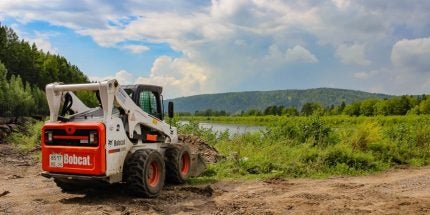
Russia is continuing with clean-up of its nuclear legacy sites dating from the Cold War and weapons production. Used pools with liquid radioactive waste (LRW) are usually dewatered, isolated with water-resistant rocks, and subsequently monitored through monitoring wells around the perimeter to see if there is any migration of contamination. However, in water protection zones, according to the law, this is not possible. Therefore, in the open storage basin No 365 at the Mining & Chemical Combine (MCC) in Zhelznogorsk, Krasnoyarsk Territory, a new method was used for the first time in the history of the Russian nuclear industry, based on the “liquidation” option.
During the development of Soviet nuclear weapons, the vast majority of technologies were newly developed. They were tested and implemented often on the same industrial site, and in an extremely short time. Therefore, as with all the nuclear weapons states, a legacy of radioactive waste was left for future generations to eradicate. Open storage pool No 365 was created in 1958 as part of the liquid radioactive waste management system. Its main purpose was as a safety barrier in case of emergency water discharge from industrial uranium-graphite reactors that produced weapons-grade plutonium.
Over the entire period of its existence, notes Daniil Zhirnikov, Director of the Decommissioning of Nuclear & Radiation Hazardous Facilities at MCC, not a single leak through the drainage has been recorded, and the waterproofing of the pool was reliably ensured by an anti-filtration screen.
By the mid-2010s, according to estimates, about 1.1 million Curies of radioactivity had accumulated there (mainly caesium-137 and cobalt-60 in the liquid phase). A unique artificial reservoir on the right bank of the Yenisei is located in a water protection zone. And the inclusion of the decommissioning of the pool in the federal target programme “Ensuring nuclear and radiation safety for 2016–2020 and for the period until 2035” (FTP NRB-2) turned out to be very opportune.
With the cessation of use of the pool, preparatory measures for liquidation began. At public hearings in the Zheleznogorsk administration, the project was approved. Inventors from the plant have developed a unique technology for washing out and removing bottom silt deposits. The fact is that the main activity, as surveys showed, was hidden in the silt, so it had to be dealt with before pumping out the main volume of the liquid. The experimental stand was awarded a silver medal at the XVIII Moscow International Salon of Inventions & Innovative Technologies Archimedes.The technology tested at the stand formed the basis for the project of a sludge removal unit using non-standard equipment.
A pumping station, a pavilion with buffer tanks and a pipeline were installed on the shore of the pool, through which the settled pulp (aqueous suspension with active suspensions) was sent to the liquid radioactive waste management scheme. Pumps and technological equipment that pumped out bottom sediments were placed on a floating platform that gradually moved along the water surface of the pool. This removed the bulk of the silt deposits. Now the personnel of the nuclear and hazardous waste decommissioning service are dismantling five main pipelines with a 1,400 mm diameter and a total length of over 3 km, which carried waste water from the industrial reactors.
“Next year it is planned to completely remove the remaining silt deposits and liquid radioactive waste in the basin in the form of an aqueous solution,” said the head of the service, Sergei Meshkov. “We will work with a dredger — a universal domestic amphibious complex that allows us to break up and transfer dense sediments compacted in the most inaccessible places through a floating slurry pipeline. In another year, it is planned to dismantle, fragment and sort by radioactive contamination the asphalt concrete substrate — the anti-filtration screen that has provided waterproofing for the pool for decades.”
He added: “More than 80,000 cubic metres of waste will be sifted through round drum screens, placed in soft containers—bags for transporting slag, and transported to a temporary soil disposal site. Now six frame structures with a total area of more than 40,000 square metres are being erected there. The meaning of temporary disposal of radioactive waste is purely practical: after a certain period, this soil can be used to backfill another facility being decommissioned. In this way, we not only do not involve pure natural materials and preserve the environment, but also significantly reduce the volume of waste that ends up at the final isolation points for radioactive waste.”
As long as there is residual radioactivity in the pool, it is undesirable for ducks to land on the water surface. They are driven away by a loudspeaker that plays the screech of a hungry eagle at irregular intervals. In three years, the bowl of the former pool will be levelled with clean soil and seeded with grass. A green lawn will appear in the water protection zone of the great Siberian river, and the need for a bird repeller will disappear.






